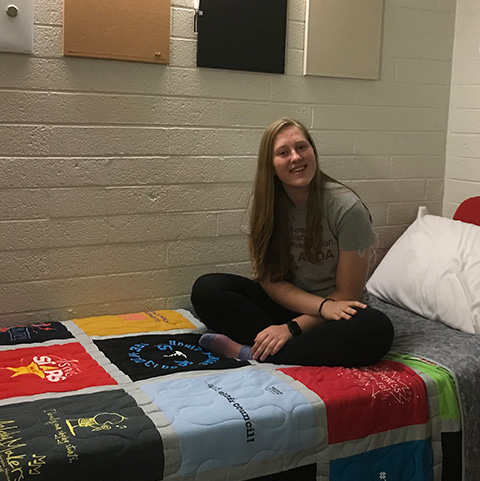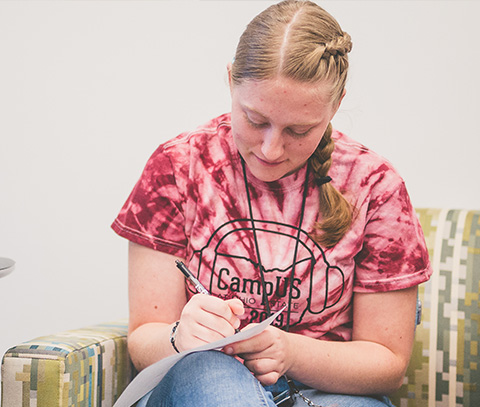I had to accept that every class will be different and that I can’t prepare too much for it. I had to learn to be adaptable and that I would learn what I need best once the class starts.
Getting Ready for College in the Time of COVID-19

Having had a cochlear implant since I was thirteen months old, hearing and living with one is all I know. Now, at nineteen years old, I use a Naída Q90 in my right ear and a Naída Link CROS in my left. For those unfamiliar with CROS, it is a small hearing aid-like device that that I wear on my non-implanted left ear. It picks up sound from that side and delivers it to the sound processor on my right. This way, I can hear from all around me. I am currently attending Northern Arizona University, and come this Fall, I will be a sophomore.
College is not high school
Moving from high school and going into college came with many unexpected academic changes. In high school, my class set-ups very rarely changed. Each class had similar class sizes, and classrooms were similar in size with similar seating arrangements.
But in my first semester of college, I found this consistency is no longer to be expected. There are large lecture halls, small lecture classes, and small interactive discussion-based classes. There are every arrangement of desks and tables that I didn’t even know were possible. There’s virtually no element of consistency. I had to accept that every class will be different and that I can’t prepare too much for it. I had to learn to be adaptable and that I would learn what I need best once the class starts.
This was a hard concept for me to grasp. I grew up learning to prepare and plan for everything. Before college, at the beginning of each semester, I would plan where I was going to sit, if the teacher would wear a Roger or if I’d control Roger from my desk. I found out ahead of time what class structure was like, whether the instruction would rely on videos or notes, and what other accommodations could be used in that class.
Take the time to adapt
In college however, it took me a couple of weeks of adjusting and adapting to each class. Because each class was so drastically different, I had to try multiple solutions with each one until I found what worked best. The most challenging were the larger classes because they were so unfamiliar to me. I had never been in a classroom that could hold more than 50 students before!
Nevertheless, on the first day of each class, I always went up to my professor after class and talked to them about my deafness. I told them about my cochlear implant and I informed them on some of the accommodations that I would need. I also told them that it may take me a couple classes to figure out exactly what I needed for their class, and that I would update them as I figured out exactly what that was.

Once I figured out what I needed, things were smooth sailing from there. My professors were very kind, understanding, and helpful as I took my time figuring out what I needed. I found that communication really helped with this!
What worked for me
I have found that in larger lecture style classes, strategic seating and potentially the use of Roger works best for me. For instance, my freshman psychology class took place in a large lecture hall along with 300 other students. I sat in the front row, but actually chose not to use Roger because the professor already had to use a microphone due to the size of the class. This professor was one to stay in the front of the class, so my strategic seating and her microphone was all I needed.
Since it was such a large class where I knew no one, I found it best to inform my professor beforehand that there may be times I don’t hear things. When that happened, I wrote down my questions during the lecture and asked her for clarification one-on-one after class, via email, or during office hours.


I also had smaller classes with as few as 30 people. In these classes, I was better able to utilize my Roger Select. In most of these smaller classes, they were heavily based on group discussions. This meant I had to talk to my group of classmates while in the background, there were 8 other groups talking as well. I even had one class of 80 students set up like this, which meant 16 groups all talking at once! Needless to say, this is a lot of background noise to compete with, which I later found wasn’t just an issue for me!
In this classroom set up, I always found the Roger Select to be my ideal solution. With the Select, I am able to select the microphones directed at my tablemates, and mute the rest of the microphones that are directed elsewhere. This way, I was able to eliminate the extraneous background noise while simultaneously amplifying the voices I wanted to hear. This helped me to really engage and be a part of the discussions within my group. In these classes, I would also strategically use my CROS in a similar manner. If my CROS ear was towards competing noise, I would mute that ear and thus mute the competing noise with it!
In the unlikely event of a pandemic…
When second semester came around, the adjustment period of figuring out accommodations got a little easier as I became familiar with the differences between lecture halls, larger classrooms, and smaller classrooms and what each setting entailed. Second semester I was so happy that I was able to figure everything out pretty fast.
And then!... And then like it did for everyone else, everything that could possibly change did. COVID-19 brought in-person lectures to a halt. I moved home. Classes were now online. I no longer had any in-person student/professor interactions.
Online classes call for entirely different accommodations. And each class was still completely different online. I had a mix of pre-recorded lectures, live stream video classes with the professor, and classes that just had homework assignments without lectures of any kind. Some professors made themselves available to help, others appeared practically nonexistent. I continued to learn in most of my classes, but some classes lost all meaning once things shifted online.
Each form of class was difficult in its own way, though personally I found the method of only assignments with no form of lectures to be the easiest. For both pre-recorded lecture videos and live-streamed classes, I found it essential to stream the audio to my implant, either through my Naida CI Connect or through Roger Select.
With the pre-recorded videos, it was helpful that I could pause the video, rewind, and listen on repeat until I understood something. But the downside with my pre-recorded lectures was that it didn’t include the professor's face, which would have helped me to speechread. My live-streamed classes did include the professor's face, which made it easier to follow along.
Just like in-person classes, regardless of how online learning looked for each class, I made sure to reach out to my professors as needed to educate them and make them aware of the challenges that I face with their class in an online form. More often than not, the professors were willing and happy to problem solve with me!
Looking forward to another school year
As I prepare for another semester, things are once again up in the air, something that seems to be the new normal for everyone. At the point of writing (mid-July, 2020), I’m not entirely certain what each of my classes will look like, other than that they will be mostly online in some form.
Right now, I am prepared to be fully adaptable to both learning online and in person. I have all the resources and accommodations available to me that I could need for both methods of instruction. I am also preparing for the fact that I will have to find new ways to adapt to a classroom setting with myself, students, and professors wearing masks. This is now a required part of campus life, not just inside the classroom. I envision that I will be utilizing my Roger Select much more. But like everything else, I just won’t know until it’s happening.
This can often be one of the hardest parts about figuring out accommodations for myself. Oftentimes, I can’t prepare for the accommodations I need until I’m in the situation and can understand what I need.
The most important thing that I learned, is that while my accommodations may be determined in the moment, advocacy should happen during those moments and every moment before and after.
But the most important thing that I learned, is that while my accommodations may be determined in the moment, advocacy should happen during those moments and every moment before and after. Advocacy doesn’t come and go, it’s one factor that remains a constant in order for everything else, such as the accommodations, to happen!
So my advice to everyone heading to school year is this. Don’t stop advocating for yourself, especially when heading into brand new situations. Be willing to adapt, be patient with yourself, don’t be afraid to ask for help, and it will all work out.
